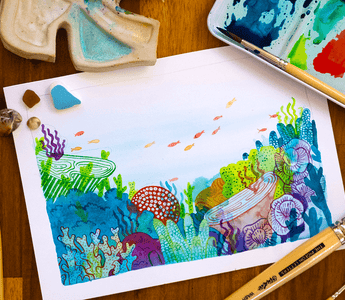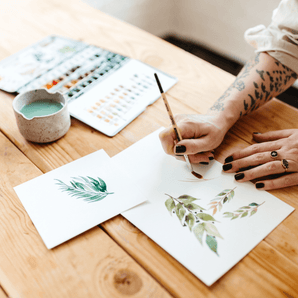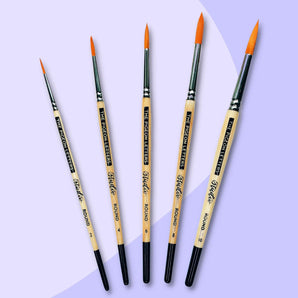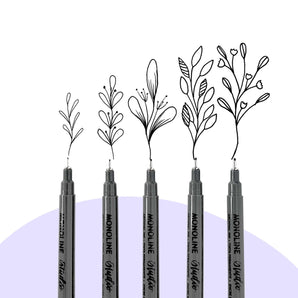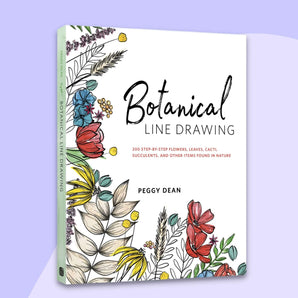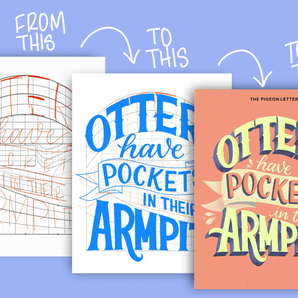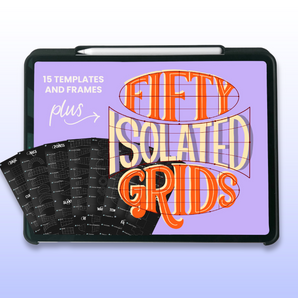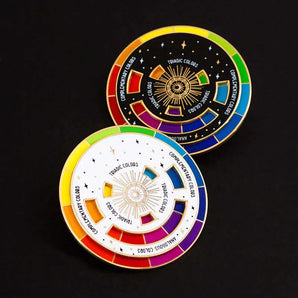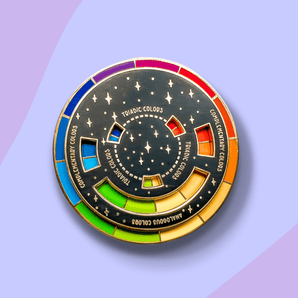I know, I know, it’s winter in the Northern Hemisphere, so today we are going to paint a scene from where you’d rather be: swimming in the warm ocean, through a beautiful coral reef! Along the way, I will share a few of my favorite modern watercolor techniques, from layering your colors to blending soft textures and graphic lines!
I am Amandine Thomas and I am with the Pigeon Letters design team! There is nothing I love more than using watercolors in unexpected ways, whether it be by using unusual tools, surfaces or techniques. So dive in (pun intended) and let’s go on a creative adventure… under the sea!
Supplies:

- An A5 piece of 300gsm paper (I use Bristol because it works better with a nib)
- A simple pencil and eraser
- A watercolor set
- The Pigeon Letters wash brush
- The Pigeon Letters round studio brushes in size 3/0, 4 and 6
- The Pigeon Letters liner brush in size 20/0 and/or
- A sergeant major nib
Watch the tutorial!
Step 1: Sketch Your Coral Reef

So first, you are going to lightly sketch your underwater scene. If you need a photographic reference for your reef, that is 100% fine, of course, or you could follow along with me (I have painted many a coral reef in my illustration work)!
Start by tracing a white border around the page. You can also mask it with tape if you want cleaner edges. Then, roughly sketch various types of coral. They can be based on your visual reference, or come straight out of your imagination: branchy ones, pin cushion-shaped ones, tube ones… have fun with it!
Of course, this sketch isn’t set in stone, and you might end up making adjustments to it as you go, but it’s a good way to figure out your composition, and the elements you want to include in your scene. Talking about composition, you can gently guide the eye into your artwork by having coral framing both the sides and the bottom of the page, forming a “U” shape. This very inviting composition will make anyone want to dive in!
Step 2: Create a Watercolor Wash

Next, you’re going to get your wash brush, and start by generously wetting the paper. You don’t want so much water that your paper turns into a puddle, obviously, but you do want it to be quite humid. Then, while the paper soaks up the water, you can mix the color for your background.
I used some phthalo green and blue and some cobalt turquoise to create a nice, deep, rich aqua, but feel free to come up with your own hue! It will look quite dark on your palette, but it will become softer as it soaks into the paper.
Next, you can grab your wash brush again, and, starting at the bottom, paint a series of horizontal strokes. Once your color runs out, start over at the bottom again, working your way up: this will ensure that you have a darker, more pigmented color at the bottom of the reef, where there is less light reaching the ocean floor. You can go over as many times as you want, and watch the color naturally dilute and blend to create a gradient! Don’t worry if your strokes go a bit streaky as the paper starts to dry: it actually works perfectly to evoke water, its different currents and depth, and the way light plays tricks under the surface!
 To finish your watercolor wash, you can go over one last time with just water.
To finish your watercolor wash, you can go over one last time with just water.
Step 3: Create Some Watercolor Blooms
Next, grab your size 6 round studio brush, and, using the same color you made for your background, let a few drops of paint fall at the bottom of the page, then watch it fuse out and blossom! At first it will look quite intense, but as the water works its magic, the color will slowly lose in strength.

You can also use other colors, keeping underwater hues in mind: blues, greens and purples work a treat, as well as the occasional red or yellow for a touch of warmth, but do limit yourself to 5 or 6 colors only, as we tend to see less color underwater.
If the paper has already started to dry, that’s ok, you can add more water, and even let the colors bleed into each other. Of course this isn’t a process you can control, and there is a lot of luck at play here, so feel free to improvise, and go with the flow! At the end of day you can’t predict what this is going to look like, so you have to trust the process. But one of the great advantages of painting nature is how forgiving it is: nothing is truly symmetrical and clean, so you can follow your intuition and forget about perfection!

Once you’re happy with the colors and how it’s looking you can stop, and of course we’re going to let this dry!
Step 3: Create Unexpected Textures
As your background starts drying, it will be looking a lot less saturated, and much softer. To add a bit of depth to it, grab a bit of paper tissue and gently blot the humid areas, to create lovely, organic textures. Perfect for coral!
Step 4: Draw Graphic Elements on Textured Backgrounds
Now that you have a beautiful, textured background, you can pick up either your sergeant major nib, or your liner brush, and start adding some graphic elements to the page. There is so much you can do with watercolor beyond the soft, cute, pastel vibes it’s famous for!
Using a Nib
If you decide to go with the nib, simply pick up a brush and use it to gently drop color into the nib. Don’t be intimidated, drawing with a sergeant major nib is very similar to using a fine liner: it has a similar resistance as you draw, and you have to apply the same kind of pressure to the tip, making it perfect for very detailed, delicate line work. If you are like me, and you consider yourself more of a drawer than a painter, then this is an excellent technique to bring the delicate colors and flowy textures of watercolor into your work without losing super sharp, super crisp line work!

You can also use the nib to add fun, graphic patterns to your coral, like cute dots, bold stripes, or striking lines, and layer them on top of the beautiful, soft texture you created earlier. Because you are only working the outlines here, you are letting the existing background do the work, both in terms of textures and color. The juxtaposition of these graphic patterns over the wet-on-wet techniques used for the background makes for something a little bit more interesting and fun!

Using a Liner Brush
You can obtain really similar effects with a liner brush: really, it’s just a matter of preference! Once again I am more of a drawer, so I am more comfortable using a nib than I am using a brush, which requires more of a light, flexible hand.

That being said, one of the main differences between the nib and the liner is that your strokes won’t be as crisp with a brush (that’s the advantage of the rigid, less flexible nib), but what you lose in sharpness, you’ll gain in texture: your line work will retain a lot more fluidity and water effects. This makes for a more versatile result! You want a solid line? Use less water! You’re after a textured stroke? Simply add water! You can also mix and match these effects, and alternate between sharper strokes, and mellow, watery ones, bringing a sensitive, emotive quality to your work.


Looking for some more watercolor inspiration?
Step 5: Use Transparency to Your Advantage
For the painters amongst us, we’re going back to round brushes, and what watercolor is designed for: transparencies and layers! Pick a color within your underwater palette (a deep purple, a rich aqua, an acid green…) and start painting a solid shape. Thanks to the beautiful transparency of watercolor, your textured background and color blooms will slowly come through, creating luminous gradients and variations within your solid color, and bringing depth to the artwork.

Then, you can either let it dry and come back to it later, to layer graphic effects on top and lift it up a bit perhaps, or use your nib to draw on the slightly humid paint: the stroke will fuse and spread, creating a softer, gentler effect.
 And while we are on the subject of wet-on-wet techniques, you can also bring the watercolor bloom right to the reef! Add a light colored wash to the corals you have previously drawn, making sure the outline has dried. Then, pop drops of color on the paper, letting the color fuse and spread, layering textures upon textures for a richer, deeper effect! You can either leave it untouched, or come back to it later and layer a pattern on top.
And while we are on the subject of wet-on-wet techniques, you can also bring the watercolor bloom right to the reef! Add a light colored wash to the corals you have previously drawn, making sure the outline has dried. Then, pop drops of color on the paper, letting the color fuse and spread, layering textures upon textures for a richer, deeper effect! You can either leave it untouched, or come back to it later and layer a pattern on top. 
You can also layer dense, saturated paint on top of your graphic patterns, to bring contrast and a touch of boldness to the artwork. Painting simple silhouettes and shapes, layer the color on top of your previous drawings to accentuate the feeling of swimming through the reef. Almost like a scene in a movie, you can imagine the camera panning in as you swim through layers of coral! 
Step 6: Mix and Match!
Working your way from foreground to background, use a mix of these techniques to paint your reef, sticking to your color scheme to make sure you retain that underwater feel. Remember to follow your gut, and trust your intuition: if at any point you feel like there is something missing, or if it didn’t work out quite like you wanted to, you can take the time to make amendments!

Feel free to try things out and play, mixing solid color and simple line work, layering patterns on textures, playing with soft or harsh contrasts, letting colors bleed into each other… The possibilities are endless! Obviously you don’t have to use all the techniques demonstrated here: I’m simply giving you some tools and ideas to explore, keeping in mind that trial and error plays a huge role in creativity, and in developing a personal style.

Step 7: Add the Final Touches
Once you are happy with your reef, it’s time to finalize your artwork! And all that is missing are some small, fun details, like seaweeds, or little fish.
So, going straight for super flowy, textured strokes with your number 4 round studio brush, paint some algae directly on top of the artwork, using your established color scheme. These spontaneous, flowy elements will add an illusion of movement, of deep currents, and add to the atmosphere, while enhancing the artwork with lovely transparencies. Next, pick up your liner brush to paint a school of little fish, using the warmer hues in your scheme. Keeping the shapes really simple, add the fish where you feel they might complement the “U” composition, further guiding the eye in.
Next, pick up your liner brush to paint a school of little fish, using the warmer hues in your scheme. Keeping the shapes really simple, add the fish where you feel they might complement the “U” composition, further guiding the eye in.

And that’s it, you’ve completed your underwater scene! I hope that you learned a few new watercolor techniques along the way, and, more importantly, that you will be inspired to explore and play more to develop your own! And if you decide to share your artwork on social media, I’d love love love to see what you made of this, so please tag @amandinethomas and @thepigeonletters!
In the meantime, happy painting!


See all of Amandine’s tutorialson the blog!
At age four, Amandine announced to a bewildered family that she would become a children’s book illustrator, and grew up writing and illustrating short stories. Fast forward to present-day, not much has changed: Now an award-winning author and illustrator, her playful illustrations and empowering stories make big themes accessible to little humans all around the world.

